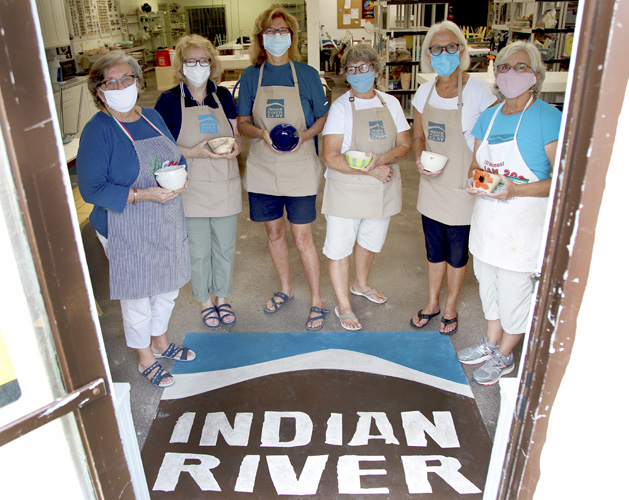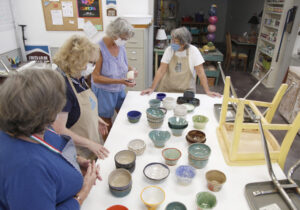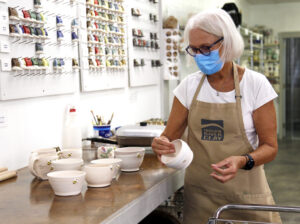
This year’s 28th annual Soup Bowl fundraiser to benefit the Samaritan Center, a transitional residential facility for homeless families, will take place a little differently as a result of coronavirus limitations.
This year’s aptly themed “Empty Bowl; Full Hearts” event will occur Thursday, Nov. 5 at the Heritage Center, but without the delicious soups prepared by restaurants and businesses, as organizers recognized the numerous COVID-related difficulties faced by local restaurants over the past six months.

Indian River Clay artists gather around newly finished bowls.
Happily, though, thanks to the creative talents of local potters, people will still be able to get their hands on this year’s crop of handcrafted soup bowls that some 30 artists have been working on for the past two months.
Additionally, Indian River Clay members stepped up to offer its facility for production, taking the place of the Vero Beach Museum of Art, which has remained closed since March.
“We were approached by the Samaritan Center toward the end of July, which is when they decided that they wanted to go through with it, and they realized that it wasn’t possible to have the bowls made at the museum,” said Maria Sparsis, co-founder, board chair and resident artist at the nonprofit clay studio.
They implemented myriad safety precautions and dedicated August and September to the Soup Bowl, spreading the process over two months rather than two weeks.
“It has always been a homecoming for all of us. Everybody gets together and it’s kind of like a big party in a way, and that’s just not possible this year,” Sparsis explains.
On the plus side, Indian River Clay moved this past year into a new 4,000-square-foot facility on 16th Street. In addition to the space being considerably larger than the museum’s, studio members have 24/7 access, which helped limit the number of people at any given time.
“It’s been really low key, but I was amazed at how many people showed up and did their thing,” says Sparsis. “Some people chose to get the clay and work at home, and I don’t blame them, but it’s never been crowded. We’ve never had to get closer than 6 feet from each other.”
Ginny Piech Street, a co-founder and their part-time studio manager, said they appreciated the chance to show off the “fabulous new space” with potential new members, adding, “We’re tickled to death that all of these people have stepped up. It’s no surprise, because they do it every year, but we’re glad we could facilitate it this year.”
She and Sparsis agree that the spurt of creative energy has given everyone a boost.
“I’m not happy with the whole COVID thing, but it’s caused us to move out of our comfort zone and look at things in a different way,” says Piech Street.

Marilyn Kanner prepares to glaze her bee themed bowls
“A lot of us sort of went into this in a state of decline, because you’re not motivated to make anything when you don’t have an outlet for it. And right now, there is very little selling anywhere,” says Sparsis. “So this has really brought a lot of enthusiasm back into the studio. Everybody was excited about it; every member has participated to whatever extent they could.”
As in prior years, contributors have multiple levels of abilities and skills.
“I think that’s one of the nicer things about this event. People that can produce 100 bowls and are experienced potters will produce 100 bowls, but we’ve got potters who can make two,” says Sparsis. “And they’ll do the best they can with the two that they make, so everybody feels like they’re contributing. So, if the bowl you get is not perfect, just think of it as being support for a potter that’s really trying and will potentially be a famous artist.”
The process has been a literal trial by fire.
“We have four kilns and we’ve been firing pretty often; each bowl gets fired twice. It’s been a fun challenge to get everything fired and glazed and re-fired. It’s been a great exercise for us,” says Piech Street.
Some bowls are routinely sought out by fans, such as the little ‘turtle’ bowls made by Linda Thiessen, who annually crafts the same number of bowls as her age. We’re not telling.
“We have hand-built bowls and wheel-thrown bowls. The hand-built bowls lend a whole new approach to it; it’s fun to see what people come up with,” says Piech Street. “We have some that will by no means hold soup, but they’re symbolic of the event. People buy them to support the charity, often seeing one and saying, ‘Oh I want that,’ and not necessarily thinking about it for soup.”
Sparsis says she gets her creative juices flowing by making a new bowl design with each bag of clay.
“So my bowls tend to come in sets of 16, because that’s how many bowls we get out of a bag of clay. So it’s 16 of this, 16 of that, 16 of the next thing, because otherwise I just get bored,” says Sparsis, who has so far crafted 97 bowls.
Included in her sets are little bean pots with handles, and ramen noodle bowls that can hold chopsticks, with a turtle-shaped cutout on one side and a rest on the opposite rim.
Husband Randy Hagood, who Sparsis taught to throw during the shutdown, produced three bowls.
“They look really nice but that’s how many he could produce this year so that’s how many he made,” says Sparsis. She also partnered with him on a set of 16 shallow white bowls, into which Hagood has painted fish designs. “He can draw but I cannot, so he drew all this marine life in the bowls that I made.”
“Clay people are the best people in the whole world. I don’t know what it is, but my theory is that the clay comes from the ground and working with clay just makes you a very grounded person. That’s my story and I’m sticking to it,” said Piech Street. “The people in the studio, the people who have come in for Soup Bowl and the people who are working independently are all just amazing people. They have given so much of their time and creative energy to contribute to this over the years.”
Sparsis says Indian River Clay plans to restart a limited number of classes in October, each with limited participants.
“It’s just not the same but it’s the best we can do right now,” she says. “We used to have two classes at the same time; things like that just aren’t happening right now.”
In addition to regular memberships, they have four resident members; two of those are currently available. Resident members have their own 8-feet-by-10-feet workspace, where they can keep their own equipment, and have full use of the rest of the studio.
This year’s Samaritan Center Soup Bowl will take place from 9 a.m. to 7 p.m. Thursday, Nov. 5 ONLY at the Heritage Center. The number of people inside at any given time will be limited, and masks are required. Bowls ($15 donation per bowl requested) must be paid for by check or exact cash amounts. Some bowls will be sold as sets of four and eight.
For more information, visit Indianriverclay.org or call the Samaritan Center at 772-770-3039.



